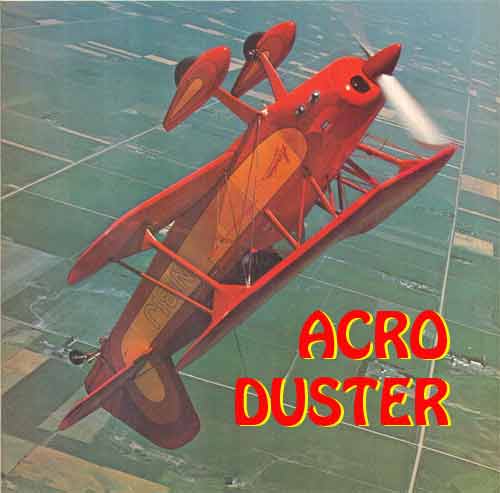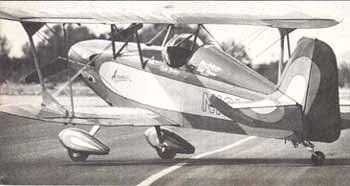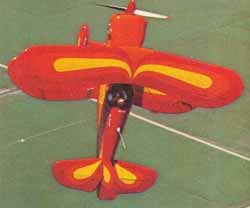 |
Acroduster
One : A Pitts Killer or a Pitts Wannabee? |
As I walked around it, I could hear myself thinking, "Well, Acroduster, are you the hot-dog akro ship Jim Osborne thinks and hopes you are?" The airplane didn't answer. It didn't even seem to notice me gingerly squirming down through the narrow space between the gigantic eyelid windshield and the turtledeck with "No Seat" painted across the top. Jim Osborne, the Acroduster's designer, wasn't there. He was back at Flabob Airport running the business he'd bought from Lou Stolp, the Stolp Starduster Corporation. But I'd seen the look in his eyes as he told me to have fun just before we took off over the hills with his airplane. The look was the same anxious look you'd find on a stage mother's face: it clearly said, "Please, like my child. Tell me she's as talented as I think she is." He knows he's bitten off a very large chunk, but in his quiet way Jim Osborne also knows his little elliptical-winged belly-button bender can chew it. The name of his game, his goal, is the same as many others in recent years: "Beat the Pitts Special." However, Osborne knows that except for Leo Loudenslager's personally modified Stephens Akro, no one has come close. Still, Curtis Pitts must get awfully tired of playing king of the hill.
As I strapped in, I couldn't help but feel as if I were there to test a legend. not that of the Acroduster, but of Curtis Pitts, my friend and a man to whom all of sport aviation owes a very great debt. I felt I might be betraying him. But I had to find out. I had to see if the Acroduster was the airplane that was going to nip away at the Pitts and possibly bring an era to a close. All of this background intrigue was rattling around in the back of my mind as Eric Shilling, exFlying Tiger and Osborne's test pilot/cohort, yanked the prop through on the 180 hp Lycoming. I fished my feet up off the floor pan to get on the toe brakes and held on tight, my eyes roaming around the cockpit. The cockpit is not only huge, almost tub-like in its dimensions, but it's not at all what biplane drivers are used to looking at. The rivets that hold the sheets together and the folded angles and aluminum extrusions all look out of place hanging between two beautifully formed fabric wings. The wing planform shows that Osborne made an effort to stick to the Stolp Starduster's pretty-wing mold. but the fuselage is something else entirely. Were it not for the breeze blowing through the open flight deck and the shadow from the top wing I could easily have been sitting in a Midget Mustang or similar sheet metal bird. It felt strange and a little disquieting to saddle up fobiplane aerobatics and not be nestled in the usual thatch of chrome-moly tubing. Then the Lyc barked its opening notes and torqued the fuselage back and forth like a kid at a stop light in a 427 Chevy. It meant business. Hopefully, so did I.
Earlier in the day my curiosity, whetted by a smidgen of caution, goaded me into making a careful examination of the airframe. It immediately became obvious that Osborne had either made an equally probing examination of a Pitts and then decided to do everything differently, or he had started with a clean sheet of paper. I tend to think he profited from Mr. Pitts' twenty-five year public love affair with his biplane. Osborne appears to have carefully noted the areas in which Pitts has had problems and then designed away from those troubles. That doesn't mean Osborne has designed a trouble-free airframe, but when his flavor of problems begin to show up under the strain of all-out unlimited competition, they will probably be different than Pitts'. For instance, the Acroduster I was flying had landing wires running all over the place. That's because Osborne is trying to avoid the rib breakage and aileron kinks of the Pitts, which many attribute directly to the flying/landing wire arrangement. There is only one set of each. The Acroduster uses two. Osborne also went the opposite direction in designing the cabane and center wing joint. The Acroduster uses completely separate wing panels pinned in the center with a pivot type joint and tied to the fuselage with an open stance cabane that has four mounting points on the wings. The Pitts has an inverted "V" cabane with only two mounts on the one-piece upper wing. One of my Pitts-building friends refers to the upper wing as his "17-foot white elephant" because after he made the critical upper-spar splice, he found he had a clumsy little knickknack that required two men to move around without dinging it.
|

